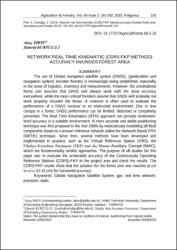Network Real Time Kinematic (CORS-FKP Method) Accuracy in/Under Forest Area
Citation
Pırtı, A., & Kurtulgu, Z. (2023). NETWORK REAL TIME KINEMATIC (CORS-FKP METHOD) ACCURACY IN/UNDER FOREST AREA. Agriculture and Forestry, 69(2).Abstract
The use of Global navigation satellite system (GNSS), (geolocation and navigation system) in/under forestry is increasingly being established, especially in the areas of logistics, inventory and measurements. However, the uninitialized forest user assumes that GNSS will always work with the same accuracy everywhere, while the more critical foresters assume that GNSS will probably not work properly in/under the forest. A criterion is often used to evaluate the performance of a GNSS receiver in an obstructed environment. Due to tree canopy in a forest, GNSS performance can be limited, disturbed or completely prevented. The Real Time Kinematics (RTK) approach can provide centimetre-level accuracy in a suitable environment. A more accurate and stable positioning technique was first proposed in the mid-1990s by meticulously modelling all fault components based on a known reference network called the Network Based RTK (NRTK) technique. Since then, several methods have been developed and implemented in practice, such as the Virtual Reference Station (VRS), the Flächen Korrektur Parameter (FKP) and the Master-Auxiliary Concept (MAC), which are fundamentally similar approaches. The purpose of all studies for this paper was to evaluate the achievable accuracy of the Continuously Operating Reference Stations (CORS)-FKP in the project area and check the results. The CORS-FKP results show that the solution for the forest area was reached at cm level (±10-15 cm) for horizontal accuracy.


















